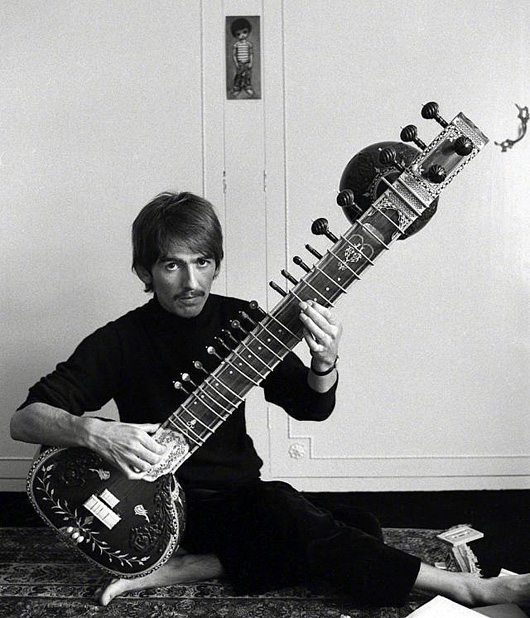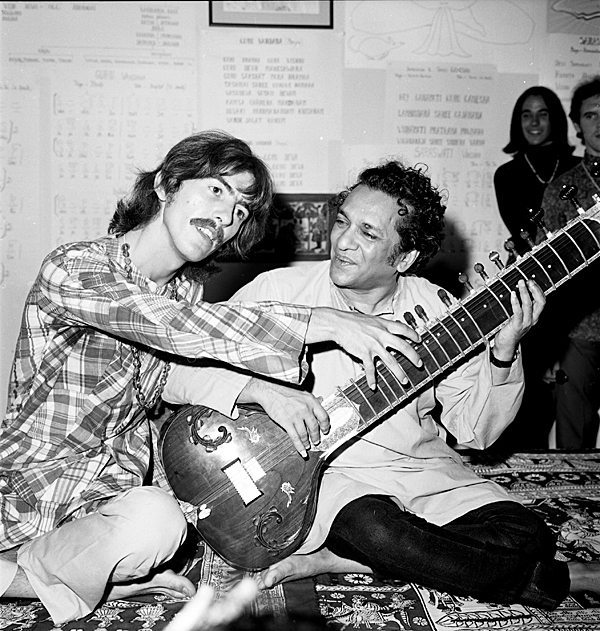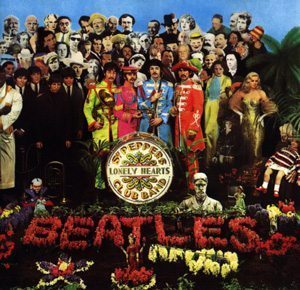
There are some who simply assume that George Harrison’s love
for Indian music dates from around the time he and the other Beatles
went to the Maharishi Mahesh Yogi’s lecture in London on 24 August 1967.
In fact George’s interest was piqued in April 1965 when the Beatles
were filming Help! in April 1965.
“We were waiting to shoot the scene in the restaurant when the guy
gets thrown in the soup and there were a few Indian musicians playing in
the background. I remember picking up the sitar and trying to hold it
and thinking, 'This is a funny sound.' It was an incidental thing, but
somewhere down the line I began to hear Ravi Shankar's name. The third
time I heard it, I thought, 'This is an odd coincidence.' And then I
talked with David Crosby of The Byrds and he mentioned the name. I went
and bought a Ravi record; I put it on and it hit a certain spot in me
that I can't explain, but it seemed very familiar to me. The only way I
could describe it was: my intellect didn't know what was going on and
yet this other part of me identified with it. It just called on me ... a
few months elapsed and then I met this guy from the Asian Music Circle
organisation who said, 'Oh, Ravi Shankar's gonna come to my house for
dinner. Do you want to come too?”

In October 1965 George was first recorded playing a sitar on’ Norwegian Wood (This Bird Has Flown)’, for Rubber Soul. “I went and bought a sitar from a little shop at the top of Oxford Street called Indiacraft - it stocked little carvings, and incense. It was a real crummy-quality one, actually, but I bought it and mucked about with it a bit. Anyway, we were at the point where we'd recorded the Norwegian Wood backing track and it needed something. We would usually start looking through the cupboard to see if we could come up with something, a new sound, and I picked the sitar up - it was just lying around; I hadn't really figured out what to do with it. It was quite spontaneous: I found the notes that played the lick. It fitted and it worked.”
The second of George’s Indian influenced songs was ‘ Love You To’ for Revolver in 1966. His third was ‘Within You, Without You’ that opens the second side of the original Sgt Pepper's Lonely Hearts Club Band LP; the only track not written by John or Paul on the album.
 George began writing ‘Within You, Without You’ on a pedal harmonium
and the song was simply labelled, ‘Untitled’ when he recorded it at
Abbey Road Studios on the evening of on Wednesday 15 March 1967. As
George later recalled, “I'd also spent a lot of time with Ravi Shankar,
trying to figure out how to sit and hold the sitar, and how to play it.
Within You Without You was a song that I wrote based upon a piece of
music of Ravi's that he'd recorded for All-India Radio. It was a very
long piece - maybe 30 or 40 minutes - and was written in different
parts, with a progression in each. I wrote a mini version of it, using
sounds similar to those I'd discovered in his piece. I recorded in three
segments and spliced them together later.”
George began writing ‘Within You, Without You’ on a pedal harmonium
and the song was simply labelled, ‘Untitled’ when he recorded it at
Abbey Road Studios on the evening of on Wednesday 15 March 1967. As
George later recalled, “I'd also spent a lot of time with Ravi Shankar,
trying to figure out how to sit and hold the sitar, and how to play it.
Within You Without You was a song that I wrote based upon a piece of
music of Ravi's that he'd recorded for All-India Radio. It was a very
long piece - maybe 30 or 40 minutes - and was written in different
parts, with a progression in each. I wrote a mini version of it, using
sounds similar to those I'd discovered in his piece. I recorded in three
segments and spliced them together later.”
George had an Indian friend playing tabla and the Beatles’ engineer,
Geoff Emerick does a wonderful job of recording the instrument in a way
that enhances the track so much. George was the only Beatle in the
studio that day and it’s him and Neil Aspinall playing tamburas with the
dilruba and svarmandal played by Indian musicians from the Asian Music
Centre in Finchley Road, North London. Two more dilrubas, it’s similar
to a sitar but played with a bow, were overdubbed on 22 March; violins
and cellos were added on 3 April. Later that evening George recorded his
lead vocals, a sitar part and acoustic guitar. ‘Within You, Without
You’ was finished and according to John Lennon, “One of George's best
songs. One of my favourites of his, too. He's clear on that song. His
mind and his music are clear.”
As a footnote, the version that is included on The Beatles' The Anthology 2
is purely instrumental and it is heard slowed to its original key and
speed. Later in the year George continued his exploration of Indian
musical ideas when he began work on the soundtrack to the film
Wonderwall.

No comments:
Post a Comment